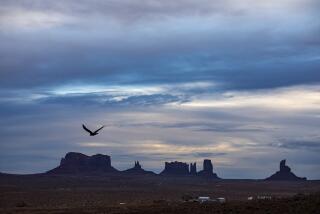Zimbabwe’s 2nd Largest City May Die of Thirst
- Share via
BULAWAYO, Zimbabwe — Zimbabwe’s second largest city may die of thirst unless a campaign to stretch its dwindling water supply succeeds.
“If we fail in this program . . . then Bulawayo will certainly die,” said Town Clerk Mike Ndubiwa, referring to a conservation campaign and plans to develop a more reliable source of water.
“Industries will be forced to close and people will have to be evacuated,” he told Reuters.
This gracious, far-flung city in the dry plains of Zimbabwe’s southwestern Matabeleland province has been hit hard by the severe drought ravaging southern Africa.
The city has only about 18 weeks of water left in its reservoirs.
The government has declared the city a water shortage area and promised to marshal emergency funds to improve short-term supplies, starting with tapping underground water from another district.
Bulawayo’s city council has cut each household’s water allowance to 105 gallons a day. The average household has 10 people, and some have 20 people because of an acute housing shortage.
Ndubiwa said the city is considering more stringent water rationing to stretch current supplies. “I don’t think we have a choice in the face of this serious drought,” he adds.
Experts say that tighter rationing could stretch the water supply until next March.
The city council is pressing its “save-water” campaign with a nightly prime-time advertisement on Zimbabwe television.
And under the slogan “Bulawayo must live,” the council is pleading with the Zimbabwe government to support a city plan to build a water pipeline from the huge Zambezi river bordering Zambia, 300 miles to the north.
A voluntary fund has been established to help finance the multimillion-dollar project, but local officials have not given up their six-year-old campaign for government backing.
“The government must see and hear our plight, because at the end of the day the Zambezi water pipeline still stands out as our only lasting hope to this crisis,” Ndubiwa said.
But the government, citing prohibitive costs and the lack of proper planning, has held out on the project, expected to cost $180 million.
Local officials say the government’s stance has discouraged international donors.
“I am sure if this was for Harare, the project would have long been finished,” said Mike Constandinos, an outspoken council member and a leading supporter of the Zambezi water pipeline.
Backers of the scheme say it would turn the arid Matabeleland province into a greenbelt of cotton and other crops and help reduce unemployment among thousands of school dropouts in the area.
Traditional distrust between Matebeleland, home to the warrior Ndebele people, and President Robert Mugabe’s government, dominated by the northern Shona people, has kept tempers short on both sides.
Some Ndebeles believe the government is trying to “fix” them for their previous support of veteran politician Joshua Nkomo’s opposition ZAPU Party in the first seven years of black majority rule, from 1980.
Nkomo, a Ndebele, merged his party with the ruling ZANU-PF Party in 1987, and is now a vice president under Mugabe. He has kept a low profile in the Zambezi water pipeline debate, which has been championed instead by junior Ndebele minister and former ZAPU security chief Dumiso Dabengwa.
Industry and commerce leaders have thrown their weight behind the project, saying economic development in Matabeleland depends on a reliable water supply.
Constandinos said if the current drought persists and the government fails to do something substantial in the next few months to develop the Zambezi water pipeline, a “disaster scenario will emerge.”
He said more than a million people in Bulawayo and surrounding districts would need to be evacuated and industries would be closed.
“God forbid we get to that stage,” Constandinos said.
More to Read
Sign up for Essential California
The most important California stories and recommendations in your inbox every morning.
You may occasionally receive promotional content from the Los Angeles Times.













